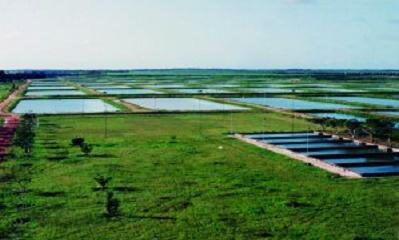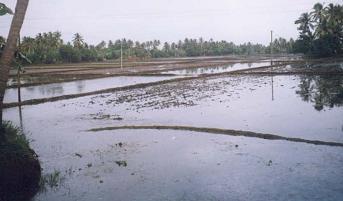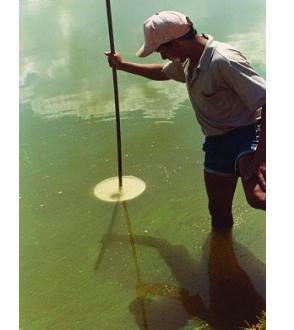|
Pond Management
Nursery pond management
The preferred stocking density in the nursery pond is 20/m2. Post-larvae
(8-10 mg) may be fed with pellet diet (crude protein 35%; lipid 8%) in crumble form
@ 100% of the biomass during the first fortnight and further reduced to 50% in subsequent
period. In the absence of pellet diet a mixture of groundnut oil cake (powdered)
and rice bran may be given as feed. The feed should be broadcasted in the pond twice
daily preferably in the morning and in the late evenings. In nursery ponds approximately
10% of the pond surface may be covered with floating weeds with dense root system
such as Eichhornia sp. to improve the survival rate of post-larvae. The
weeds should be kept inside a PVC or bamboo frame to avoid their spreading in the
pond. Aeration is provided for ~8 h/day.
A fortnight after stocking sampling of post-larvae may be done to observe the growth
using cast net or fry net. During nursery rearing water temperature may be checked
twice daily. pH, dissolved oxygen, transparency and depth may be checked once every
week and to be maintained in optimum ranges. Loss of water due to seepage and evaporation
should be compensated by water addition at least once every fortnight. Nursery rearing
may be done for 45-60 days. At the end of rearing period the juveniles (>1.0
g) are collected by dewatering the pond and transferred to grow-out ponds
Juvenile prawns can be harvested by seining your ponds two or three times with a
5 to 6 mm mesh seine, or by emptying them completely. Polypropylene boxes or tanks
filled with water from the nursery pond and kept aerated, can be used to transport
the juveniles to the grow-out ponds if they are close by. There are some advantages
in grading the juveniles into two or three groups, depending on their average weight,
before stocking them into separate grow-out facilities. This decreases competition
in grow-out ponds by reducing Heterogeneous Individual Growth (HIG) and increases
productivity. Some mortality (10-20%) will occur soon after PL are stocked, even
when the conditions are ideal. Total survival from stocking until removal from the
nursery ponds should be at least 75%. The weight of the prawns at the end of the
outdoor nursery period should be about 0.8-2.0 g, but the time taken to reach those
sizes will depend on local conditions.
Grow-out phase
A freshwater prawn farm is very similar to a freshwater fish farm. Prior to initiation
of culture the ponds should be well prepared. The pond bunds/dykes should be repaired
and strengthened. Ponds should be drained and the pond bottom should be exposed
to sun for a week to kill all predatory fishes. Rectangular ponds are suitable mainly
from the harvesting point of view. A convenient width is 30-50 m, whereas length
of the pond depends on site, topography and farm layout. Normally a size of 0.5
to 1.5 ha is found suitable. The average depth of the ponds should be 0.9m with
a minimum of 0.75m and a maximum of 1.2 m. Dike and pond slope may be kept at 2:1.
Bund must have a freeboard of at least 60 cm above the highest water level in the
pond. Designing and layout of the farms may be done keeping in view the water intake
and water outlet facilities. The drainage system should be designed carefully to
prevent mixing of outlet water with incoming water.
Lime may be applied as per the requirement after testing the soil pH. It can be
applied @ 200 kg/ha, if the soil pH is between 6.5-7.0. Higher dose will be required
in case of soil with low pH values. Water should be let into the pond up to two
feet using nylon mesh nets to prevent the entry of eggs and larvae of predatory
fishes and competitors. Pond should be fertilized with raw cow dung/poultry manure
and super phosphate as per the requirement. In general for a pond of medium nutrient
contents the fertilizers may be applied at the rate of 5 tonnes raw cow dung, 200
kg urea and 300 kg/ha/crop super phosphate. After a week of fertilization the pond
should be filled up to 4 feet water level. Transparency of pond water should be
checked after 2-3 days using a secchi disc. Ponds can be stocked with post-larvae
in case of nursery pond and with juveniles in case of grow-out ponds once the transparency
is 30-35 cm during early morning or late evening hours.

Growout ponds of freshwater prawn

Pond preparation for stocking

Top
|